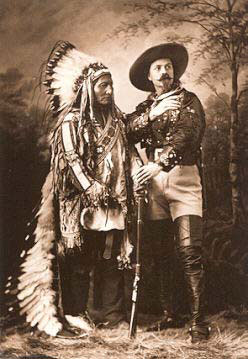Native American Relations
The Indian Removal Act of 1830 forced Native Americans, who lived east of the Mississippi, farther west. As the railroad broke Western ground and pioneers increased westward movement, Native Americans were in the position to be moved again. The Native Americans were outnumbered. The federal government and pioneers also had guns. Some groups of Native Americans, including the Navajo and Cheyenne, accepted the ability to live within reservation land that was set aside for them. They could also receive an American education, to help with assimilating into the culture, without having to leave their reservations. From the 1860s to the 1880s, settlers and federal officials fought groups of Native Americans until their tribes either died out or relocated to a reservation.

Native Americans
Settlers, who hunted, began exterminating buffalo for sport. The buffalo was a means of survival for Plains Indians. Buffalo meat was used for food and the bones and hide were used to make clothes, tepees, and tools. Soon the cattlemen’s herds would replace the buffalo. Groups of Native Americans like the Hupa and the Walla Walla who lived in timber rich areas watched as the settlers stripped the land for lumber.
 |
Chief Sitting Bull |
Many Native Americans resisted the settlers and federal authorities. Sioux Chief Sitting Bull led what is known as the Battle of Little Bighorn against Lieutenant Colonel George Custer. More than 200 American soldiers, including Custer, were killed, but in 1890, American soldiers killed more than 200 Sioux, including women and children, in what is known as the Massacre at Wounded Knee. The Apache, under the leadership of warrior Geronimo, led raids on trading outposts in the Southwest. Geronimo was eventually forced to surrender to U.S. troops in 1886.
Native American groups were communal and Americans were very individualistic. The federal government sought to break Native Americans of their communal nature and force them to assimilate with the Dawes Severalty Act of 1887. The Act gave citizenship and 160 acres of land to the heads of households of individual Native American families or 80 acres to single adults or orphans. Adults could not gain full title to the property for 25 years. The Bureau of Indian affairs even sent Native American children to boarding schools to force assimilation.